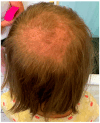Dermoscopy and Ultraviolet-Enhanced Fluorescence Dermoscopy (UEFD) Increase the Accuracy of Diagnosis and Are Useful in Assessing the Effectiveness of Kerion celsi Treatment
- PMID: 39852471
- PMCID: PMC11766397
- DOI: 10.3390/jof11010052
Dermoscopy and Ultraviolet-Enhanced Fluorescence Dermoscopy (UEFD) Increase the Accuracy of Diagnosis and Are Useful in Assessing the Effectiveness of Kerion celsi Treatment
Abstract
Microsporum canis, a zoophilic dermatophyte, infects the stratum corneum and keratinized tissues like hair and nails in cats and dogs, with cats serving as the primary reservoir. Most human infections arise from animal contact. We present the case of a girl aged 8 with skin scalp lesions persisting for two months. Several scalp lesions, with a maximum diameter of 4 cm, presented as erythematous plaques with superficial scaling, yellow crusts, and edematous areas with purulent exudate. Dermoscopy revealed yellow crusts on an erythematous background, along with white scales, pustules, broken hairs, and comma hairs. Ultraviolent-enhanced fluorescence dermoscopy (UEFD) showed slight celadon green fluorescence, which enhanced the diagnosis and further helped to monitor the treatment. The PCR test confirmed the presence of M. canis. Treatment included topical ciclopirox and oral terbinafine. Lesions on the scalp and noticeable hair regrowth were observed in the areas of hair loss after two months. Kerion celsi can result in severe alopecia. To prevent scarring associated with hair loss in children, early mycological diagnostics, supported by dermoscopy and UEFD, is recommended.
Keywords: Kerion celsi; Microsporum canis; alopecia; dermatophyte; fungal infection; zoonosis.
Conflict of interest statement
The authors declare no conflicts of interest.
Figures









Similar articles
-
Kerion Celsi caused by Microsporum gypseum in a Chinese child, a case report.Medicine (Baltimore). 2022 Apr 1;101(13):e28936. doi: 10.1097/MD.0000000000028936. Medicine (Baltimore). 2022. PMID: 35421059 Free PMC article.
-
First report of kerion (tinea capitis) caused by combined Trichophyton mentagrophytes and Microsporum canis.Med Mycol Case Rep. 2020 May 19;29:5-7. doi: 10.1016/j.mmcr.2020.05.002. eCollection 2020 Sep. Med Mycol Case Rep. 2020. PMID: 32477858 Free PMC article.
-
[Kerion Celsi due to Microsporum canis infection].Hautarzt. 2021 Oct;72(10):855-859. doi: 10.1007/s00105-021-04817-1. Epub 2021 Apr 21. Hautarzt. 2021. PMID: 33884438 Review. German.
-
Kerion Celsi due to Microsporum canis in an Adult Woman, Treated Successfully with Fosravuconazole.Med Mycol J. 2023;64(2):37-43. doi: 10.3314/mmj.22-00025. Med Mycol J. 2023. PMID: 37258133
-
Case report. Kerion Celsi effectively treated with terbinafine. Characteristics of kerion Celsi in the elderly in Japan.Mycoses. 1999;42(9-10):581-5. doi: 10.1046/j.1439-0507.1999.00488.x. Mycoses. 1999. PMID: 10592706 Review.
Cited by
-
Kerion Celsi in Elderly Female, Caused by Trichophyton rubrum: Case Report.Case Rep Dermatol. 2025 Jul 4;17(1):304-310. doi: 10.1159/000547156. eCollection 2025 Jan-Dec. Case Rep Dermatol. 2025. PMID: 40771835 Free PMC article.
References
Publication types
LinkOut - more resources
Full Text Sources
Miscellaneous

